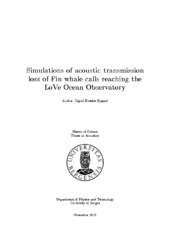| dc.contributor.author | Øygard, Sigrid Husebø | |
| dc.date.accessioned | 2019-01-07T16:41:12Z | |
| dc.date.available | 2019-01-07T16:41:12Z | |
| dc.date.issued | 2018-12-18 | |
| dc.date.submitted | 2018-12-17T23:00:03Z | |
| dc.identifier.uri | https://hdl.handle.net/1956/18847 | |
| dc.description.abstract | Equinor has plans to develop a whale monitoring station using acoustic animal destiny estimation at their cabled ocean observatory, the LoVe Observatory, in Lofoten-Vesterålen basin. The fauna of this area is of remarkable importance to the Norwegian economy due to its unique fishing banks and its newly discovered petroleum reserves. This makes it important to monitor the Fin whale population in the area, especially if human interference in the region is to be increased due to new petroleum related interventions. Moreover, the observatory will hopefully bring about new knowledge of the habitat and migratory routes of the Fin whale, which are currently poorly understood. In order to implement an animal density estimation algorithm at the LoVe Observatory it is necessary to know how the transmission loss experienced by sounds reaching the observatory varies as a function of position around the receiver. This study has developed a set of model tools fit to simulate the transmission loss at any position in the Lofoten-Vesterålen basin, by using environmental data available at various databases as input parameters to the parabolic equation model Range-dependent Acoustic Model (RAM). The study has utilized these tools to produce simulations of the transmission loss at a number of example transects, in order to present some conclusions about how the transmission loss is affected by the environmental parameters bathymetry, sound speed profiles and sedimentary geoacoustic properties. Furthermore, the simulations have been repeated for each of the four seasons, to look at how the transmission loss varies across the year. Generally, the study will show that the variation of transmission loss with position is complex and that the inclusion of environmental parameters in the simulations is necessary. It will be shown that the observatory is capable of detecting Fin whales at 190 km in low noise conditions, but that this range is limited by the angular direction of the propagation path and by increases in the noise level. Seasonal variability in the transmission loss will be shown, but it has not been possible connect this variation to the observed yearly variation in Fin whale detections. | en_US |
| dc.language.iso | eng | eng |
| dc.publisher | The University of Bergen | en_US |
| dc.subject | Akustiske signaler | nob |
| dc.subject | Finnhvaler | nob |
| dc.subject | Geoakustikk | nob |
| dc.title | Simulations of acoustic transmission loss of Fin whale calls reaching the LoVe Ocean Observatory | en_US |
| dc.type | Master thesis | |
| dc.date.updated | 2018-12-17T23:00:03Z | |
| dc.rights.holder | Copyright the Author. All rights reserved | en_US |
| dc.description.degree | Masteroppgave i fysikk | en_US |
| dc.description.localcode | MAMN-PHYS | |
| dc.description.localcode | PHYS399 | |
| dc.subject.realfagstermer | https://data.ub.uio.no/realfagstermer/c008315 | |
| dc.subject.realfagstermer | https://data.ub.uio.no/realfagstermer/c002549 | |
| dc.subject.realfagstermer | https://data.ub.uio.no/realfagstermer/c008554 | |
| dc.subject.nus | 752199 | eng |
| fs.subjectcode | PHYS399 | |
| fs.unitcode | 12-24-0 | |
